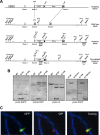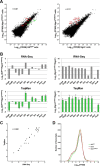RNA-Seq analysis of enteroendocrine cells reveals a role for FABP5 in the control of GIP secretion
- PMID: 25268051
- PMCID: PMC5414789
- DOI: 10.1210/me.2014-1194
RNA-Seq analysis of enteroendocrine cells reveals a role for FABP5 in the control of GIP secretion
Abstract
In response to fat intake, enteroendocrine K cells release the hormone glucose-dependent insulinotropic polypeptide (GIP). GIP acts on adipocytes to increase lipid uptake and enhance adipokine secretion, promoting weight gain and insulin resistance. Modulation of intestinal GIP release could therefore represent a therapeutic strategy for the treatment and prevention of obesity and diabetes. However, the prospects of using drugs to effectively target specific enteroendocrine cell types have been tempered by the realization that these cells share similar transcriptional programs and frequently employ common mechanisms of hormone secretion. To gain novel insights into the regulation of GIP release, we generated knock-in mice expressing green fluorescent protein (GFP) under the control of the endogenous GIP promoter that enable the isolation of a purified population of small intestine K cells. Using RNA sequencing, we comprehensively characterized the transcriptomes of GIP(GFP) cells as well as the entire enteroendocrine lineage derived from Neurogenin3-expressing progenitors. Among the genes differentially expressed in GIP(GFP) cells, we identified and validated fatty acid-binding protein 5 (FABP5) as a highly expressed marker of GIP-producing cells that is absent in other enteroendocrine cell types. FABP5 promotes intracellular transport and inactivation of endocannabinoids, including anandamide, which inhibits GIP release. Remarkably, we found that circulating levels of GIP were significantly decreased in FABP5-deficient mice in the fasting state and in response to acute, oral fat diet administration. Our findings highlight the power of RNA sequencing to uncover molecular signatures of specific enteroendocrine cell types that can potentially be exploited for therapeutic purposes in the treatment of metabolic disorders.
Figures





Similar articles
-
Fatty acid-binding protein 5 regulates diet-induced obesity via GIP secretion from enteroendocrine K cells in response to fat ingestion.Am J Physiol Endocrinol Metab. 2015 Apr 1;308(7):E583-91. doi: 10.1152/ajpendo.00543.2014. Epub 2015 Jan 27. Am J Physiol Endocrinol Metab. 2015. PMID: 25628425
-
Mechanisms of fat-induced gastric inhibitory polypeptide/glucose-dependent insulinotropic polypeptide secretion from K cells.J Diabetes Investig. 2016 Apr;7 Suppl 1(Suppl 1):20-6. doi: 10.1111/jdi.12467. Epub 2016 Mar 14. J Diabetes Investig. 2016. PMID: 27186351 Free PMC article. Review.
-
Transcriptional regulatory factor X6 (Rfx6) increases gastric inhibitory polypeptide (GIP) expression in enteroendocrine K-cells and is involved in GIP hypersecretion in high fat diet-induced obesity.J Biol Chem. 2013 Jan 18;288(3):1929-38. doi: 10.1074/jbc.M112.423137. Epub 2012 Nov 28. J Biol Chem. 2013. PMID: 23192339 Free PMC article.
-
Free fatty acid receptor GPR120 is highly expressed in enteroendocrine K cells of the upper small intestine and has a critical role in GIP secretion after fat ingestion.Endocrinology. 2015 Mar;156(3):837-46. doi: 10.1210/en.2014-1653. Epub 2014 Dec 23. Endocrinology. 2015. PMID: 25535828
-
Glucose-dependent Insulinotropic Polypeptide (GIP): From prohormone to actions in endocrine pancreas and adipose tissue.Dan Med Bull. 2011 Dec;58(12):B4368. Dan Med Bull. 2011. PMID: 22142579 Review.
Cited by
-
Dietary Vitamin A Affects the Function of Incretin-Producing Enteroendocrine Cells in Male Mice Fed a High-Fat Diet.J Nutr. 2023 Oct;153(10):2901-2914. doi: 10.1016/j.tjnut.2023.08.030. Epub 2023 Aug 28. J Nutr. 2023. PMID: 37648113 Free PMC article.
-
Physiology and clinical applications of GIP.Endocr J. 2025 Jul 1;72(7):751-764. doi: 10.1507/endocrj.EJ25-0087. Epub 2025 Apr 3. Endocr J. 2025. PMID: 40175127 Free PMC article. Review.
-
GPR142 Controls Tryptophan-Induced Insulin and Incretin Hormone Secretion to Improve Glucose Metabolism.PLoS One. 2016 Jun 20;11(6):e0157298. doi: 10.1371/journal.pone.0157298. eCollection 2016. PLoS One. 2016. PMID: 27322810 Free PMC article.
-
Mechanisms controlling hormone secretion in human gut and its relevance to metabolism.J Endocrinol. 2019 Nov 29;244(1):R1-R15. doi: 10.1530/JOE-19-0399. J Endocrinol. 2019. PMID: 31751295 Free PMC article. Review.
-
Type 2 diabetes is associated with impaired jejunal enteroendocrine GLP-1 cell lineage in human obesity.Int J Obes (Lond). 2021 Jan;45(1):170-183. doi: 10.1038/s41366-020-00694-1. Epub 2020 Oct 9. Int J Obes (Lond). 2021. PMID: 33037328 Free PMC article. Clinical Trial.
References
-
- Murphy KG, Bloom SR. Gut hormones and the regulation of energy homeostasis. Nature. 2006;444:854–859. - PubMed
-
- Wang J, Cortina G, Wu SV, et al. . Mutant neurogenin-3 in congenital malabsorptive diarrhea. N Engl J Med. 2006;355:270–280. - PubMed
-
- Roth KA, Kim S, Gordon JI. Immunocytochemical studies suggest two pathways for enteroendocrine cell differentiation in the colon. Am J Physiol. 1992;263:G174–G180. - PubMed
Publication types
MeSH terms
Substances
Grants and funding
LinkOut - more resources
Full Text Sources
Other Literature Sources
Molecular Biology Databases
Research Materials
Miscellaneous

